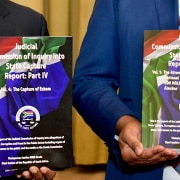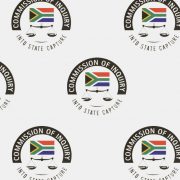|
Getting your Trinity Audio player ready...
|
With thanks to News24
UPDATE, 29 November 2017: New revelations released today seem to indicate that MultiChoice entered into a deal with with the SABC in exchange for that entity’s political influence over digital migration. The information was extracted from the minutes of a meeting held on 6 June 2013, between MultiChoice and the interim SABC board. Read more on this new development on City Press which, interestingly, is also a member of the Naspers stable, as is News24 which broke the story just days ago.
Our original post continues below:
Corruption Watch is in the business of helping to expose corruption, through a variety of platforms and methods. When our colleagues in other agencies conduct lengthy and successful investigations, we support them vigorously, and when scandals such as the #GuptaLeaks come to light, we applaud all those who were involved in further investigating the revelations brought to light by the email leak.
The latest #GuptaLeaks revelation concerns pay TV company MultiChoice, which is alleged to have made a multi-million-rand payment of R25-million to ANN7, the television channel owned at the time by the Guptas’ Oakbay Investments, among other shareholders. The company is also said to have increased its annual payment to ANN7 threefold, from R50-million to R141-million. A number of other channels on the MultiChoice bouquet have said that this vastly exceeds the payments made to them by MultiChoice.
MultiChoice has responded by defending its payment as a contribution to helping a new channel get off the ground and promoting diversity. This explanation is not persuasive – it has certainly not allayed public suspicion.
How then does one account for this unusual display of generosity? Some have suggested a link to former communications minister Faith Muthambi’s decision to push through a controversial decision in favour of unencrypted set-top boxes – against the ANC’s stated support for encryption – which benefited MultiChoice. The company had made a submission to Muthambi arguing for exactly that outcome.
In short the suggestion is that MultiChoice made an usually large payment to the Gupta company who in turn ‘persuaded’ the minister to support MultiChoice in getting its way on the choice of set top boxes. This is precisely the mechanism deployed by the Guptas to link those who, on the one hand, require a particular decision from government (MultiChoice) to, on the other hand, the government decision maker (Muthambi) using a Gupta linked intermediary (ANN7). McKinsey and SAP may recognise this modus operandi!
MultiChoice has denied “any relationship between our submission on the proclamation, the channel supply agreement for ANN7, and any fees or increase in fees paid for that channel.”
We call for absolute transparency in this matter, given the ever more apparent extent of the Guptas’ involvement in state capture. For MultiChoice to claim that it didn’t know who it was dealing with at the time, does not pass muster. South Africans’ outrage at daily revelations of state capture is, if anything, increasing. MultiChoice may think that its unassailable position in the pay TV market protects it from consumer outrage. They may be surprised. In these days when citizens are battered from all sides by new scandals coming to light almost daily, judgment in the court of public opinion will be swift and harsh.
We particularly applaud the journalists of Media24, like MultiChoice a member of the Naspers stable, for their role in raising these questions. MultiChoice should come clean. Until then the questions will not go away, and the anger and suspicion will grow.
Read the original breaking news article below, as it first appeared on News24:
MultiChoice, the pay-TV company that owns DStv and M-Net, made a questionable payment of R25m to the Guptas’ controversial ANN7 channel, the #GuptaLeaks show.
In addition, MultiChoice increased its annual payment to ANN7 from R50m to R141m.
Following the transfer of powers, Muthambi controversially pushed through a decision in favour of unencrypted set-top boxes, which benefitted MultiChoice.
Muthambi’s decision flouted her own party’s policy on the issue. The ANC supported encryption – required for pay-TV – to promote competition in the sector.
View all the related documents.
After a lengthy court battle, the Constitutional Court earlier this year ruled that it was within Muthambi’s right to make policy decisions affecting the broadcasting sector.
MultiChoice however deny that there is any relationship between the policy outcome in its favour and payments made to ANN7. In a statement, the company said: “MultiChoice rejects your insinuations in the strongest possible terms.”
The #GuptaLeaks reveal that:
- MultiChoice executive Clarissa Mack (who had since resigned) sent policy documents directly to Muthambi, who shared them with Gupta lieutenant Ashu Chawla, setting out proposals for Zuma to transfer broadcasting powers back to Muthambi after he split the communications portfolio into two departments in 2014;
- In September 2015, six months after Muthambi confirmed there would be no encryption, MultiChoice increased its annual payment to the Guptas’ controversial ANN7 channel from R50m to R141m – at a time when the channel had failed to win a significant slice of DStv’s news audience, and whilst the channel received widespread criticism over the quality of its content;
- MultiChoice CEO Imtiaz Patel was once a director of a company with the youngest Gupta brother, Tony, and Zuma’s son Duduzane. Patel says his appointment was done without his permission, and CIPC records show that he resigned from the company on the same day he was appointed.
- New ANN7 owner Mzwanele Manyi, who took over the station this year in a vendor-financed deal, said: “The so-called Gupta emails have NOT been authenticated. What if all this is part of a larger plot designed to undermine alternative voices as in ANN7?”
The Guptas did not respond to questions but have previously dismissed the #GuptaLeaks as “not authentic”.

Pay for Play
MultiChoice has been in the news recently for paying the Guptas R50m per annum for ANN7.
The pay-TV giant denied signing a “third channel amendment agreement” which would have taken ANN7’s annual income from MultiChoice to R150m, but neglected to disclose the existence of a “fourth channel amendment agreement”.
This document was unearthed in-between the more than 200 000 emails that have become known as the #GuptaLeaks.
The agreement was signed by MultiChoice’s Glen Marques and Nazeem Howa for Infinity Media Networks, ANN7’s holding company, on September 9, 2015.
The agreement not only ensured that MultiChoice would fork out R141m a year for ANN7 from April 1, 2016, but also guaranteed the Gupta-controlled company a “once off amount” of R25m.
This had to be paid to Infinity within seven days of the contract being signed, according to the agreement.
Two broadcasting insiders who had previously been involved in MultiChoice’s negotiations with news channels say such a “once off amount” is unheard of in the industry.
“The once-off fee you refer to is a pro rata payment in terms of an amendment agreement. The amendment agreement was entered into in order to assist with improving production quality,” MultiChoice said about the payment.
MultiChoice also maintains that its fee for ANN7 represented a “fair value” at the time of signing the fourth contract amendment, given the cost of running a 24-hour news channel.
“After several rounds of negotiations over a period of three years, during which we developed an understanding of the channel’s operating costs and the need for improvements in production quality over time, the final fee was set,” says MultiChoice.
MultiChoice admits that it made policy proposals to Muthambi, but the company says the majority of its suggestions were not taken up in later amendments to government legislation.
The company also denies that it was aware that Muthambi was forwarding MultiChoice’s suggestions to the Guptas.
“MultiChoice has absolutely no knowledge of the minister sending our proposals to any other person, and can in no way be held responsible for that,” says the company.
The issue at hand involves a long-running battle over whether government should favour either encrypted or unencrypted set-top boxes for the country’s digital migration process.
Critics of a policy supporting unencrypted set-top boxes argue that would-be rivals of MultiChoice can only compete with the latter’s DStv service if government enforces the roll-out of encrypted devices.
In December 2013, then-communications minister Yunus Carrim published proposed amendments to government’s digital migration policy that opened the door for encrypted set-top boxes.
But Carrim would not have the last say on the matter.
MultiChoice fingerprints in the #GuptaLeaks
After having created the separate departments of communications and telecommunications in May 2014, Zuma issued a presidential proclamation that transferred certain regulatory powers from Muthambi to Siyabonga Cwele, the then-telecommunications minister.
On July 18, 2014, only three days after the proclamation was published in the government gazette, Muthambi sent an email to known Gupta associate Ashu Chawla. She attached the government gazette containing the proclamation.
Minutes later, Muthambi again emailed Chawla, this time attaching a Microsoft Word document titled “Effect of presidential proclamation”. The document was forwarded by Chawla to Tony Gupta on the same day.
The document’s metadata reveals that its creator was Clarissa Mack, MultiChoice’s then-group executive for regulatory and policy affairs. Mack created the document on July 17, the day before Muthambi forwarded it to Chawla. Mack was also the last person to have modified the file.
Mack wrote that when Zuma created the two departments, there was an “assumption … that broadcasting including digital migration would report to the Minister of Communications”.
“The proclamation published on 15 July 2014 did not give effect to this division,” complained Mack. She also made detailed suggestions with regards to how the relevant decision-making powers should be split between Muthambi’s and Cwele’s departments.
Mack’s letter made it clear that MultiChoice wanted key powers guaranteed by parts of the Electronic Communications Act to be transferred back to Muthambi.
“Broadcasting is regulated by the Electronic Communications Act, 2005 (Act No 36 of 2005). The ability to make broadcasting policy and issue broadcasting policy directions are set out in section 3 of this Act. These powers have been transferred from the Minister of Communications to the Minister of Telecommunications and Postal Services,” Mack stated.
“It is therefore the Minister of Telecommunications and Postal Service [Cwele] who will make policy and issue policy directives to Icasa for broadcasting, including public service broadcasting,” Mack added.
Muthambi lobbies the Guptas
Over the course of the next few months, Muthambi would send Chawla four other documents relating to broadcasting policy. Chawla forwarded most of these to Tony Gupta and Duduzane Zuma, the president’s son.
On July 25, Muthambi sent Chawla a Word document called “proclamtion [sic] new 18 July 2014”.
MultiChoice has admitted that this document was also penned by Mack.
Chawla forwarded the document to Tony Gupta and Duduzane Zuma on the same day. The document stipulated in detail which aspects of the Electronic Communications Act Muthambi wanted to be moved from Cwele back to her.
“These sections must be transferred to the Minister of Communications,” Muthambi wrote to Chawla.
The document specifically focused on the parts of the Act dealing with the Independent Communications Authority of South Africa (Icasa), one of the key government bodies involved in the digital television migration process.
Muthambi also sent Chawla a Word document called “Responsibility for Infraco and Sentech” on July 25, adding in her email that “Sentech’s signal distribution must rest with the Ministry of Communications”. Apart from Icasa, Sentech is a key role-player in the digital migration process, whilst Broadband Infraco is a state-owned telecommunications company.
This document was also created by Mack, according to MultiChoice.
Perhaps the most shocking aspect of Muthambi’s communications with Chawla came in the form of a document called “final proclamation 01 August”, sent by the minister to the Gupta associate on the date mentioned in the document’s title.
“See attached Proclamation that President must sign,” Muthambi wrote Chawla, who subsequently forwarded it to Tony Gupta.
The proposed proclamation stipulated that control over section 3 of the Electronic Communications Act needed to be transferred back to Muthambi, exactly as Mack had originally pleaded in her letter.
It also included the proposed changes to the Icasa Act that Muthambi had earlier sent to Chawla.
Asked whether Mack had also created this document, MultiChoice said:
“As mentioned previously, MultiChoice, like other companies in the sector, regularly engages the industry regulator and government on matters that affect the broadcasting sector. This includes making proposals that may take a specific regulatory or legislative form. Yes, this document was sent to Ms Muthambi. The proposals were inserted in a legislative template we took from previous Proclamations in the Government Gazette. Again, many of our proposals were rejected.”
Muthambi uses her powers
On November 25, Zuma signed proclamation 79 of 2014. With the stroke of a pen, Zuma gave legislative effect to the transfer of some of the powers advocated for in Mack’s documents.
Muthambi wasted little time to make use of her newly-won policy powers. In March 2015, she stunned the broadcasting industry by issuing an amendment to government’s digital migration policy that went directly against her own party’s stance on the matter.
The new set-top boxes would “not have capabilities to encrypt broadcast signals,” declared a clause Muthambi inserted in the amendment.
Only two months before, at the ANC’s January lekgotla, the ruling party stated that it supported Carrim’s December 2013 policy, which had paved the way for encrypted set-top boxes.
In her response to News24, Muthambi admitted that she had received “submissions” from MultiChoice “sent … through Ms Mack”. But Muthambi says that she had “opened the door” for such submissions after the July 2014 proclamation caused “confusion and uncertainty” over which of the two departments would be responsible for broadcasting policy.
“The minister denies having been influenced by any person in the finalisation of the digital migration policy after consideration of all submissions by all interested parties…” Muthambi’s spokesperson said in a statement.
MultiChoice also said that it was one of “several stakeholders” who made submissions to the minister. Neither MultiChoice nor the minister indicated which other parties, apart from MultiChoice, made submissions to her office.
Muthambi also failed to address News24’s detailed queries about the emails she had sent to Chawla.

ANN7’s MultiChoice bonanza
On December 4, 2014, about a week after Zuma transferred the relevant broadcasting policy powers to Muthambi, Howa sent Tony Gupta a draft “third channel amendment agreement” for the deal between MultiChoice and Infinity.
This is the unsigned document that recently surfaced in the media.
The signed “fourth channel amendment agreement”, however, reveals that MultiChoice first agreed to increase the ANN7 fee to R100m per annum, before ultimately settling on an amount of R141m.
But it is the “once off” payment of R25m that has industry insiders most concerned.
“It is unheard of. I haven’t seen any once-off payments [in] any of the agreements with MultiChoice that I’d been privy to,” said one of the industry insiders.
The two sources, along with a third industry expert with direct knowledge of MultiChoice’s agreements with news channels, all agree that even R50m per year would constitute a bad investment for MultiChoice.
“What they pay ANN7 compared to what they get from it [the agreement] makes no commercial sense. It is such a bad channel and its viewership is so low that ANN7 actually needs to pay DStv to be on their platform,” said one of the sources.
Data obtained from the Broadcasting Research Council (BRC) shows that ANN7 secured only 8.93% of DStv’s news audience in 2014, and 10.98% in 2015. Its average daily viewership figures for 2014 and 2015 were 6,215 and 8,157 respectively.
SABC News held news audience shares of 19.90% (2014) and 22.46% (2015) and it drew 12,379 and 15,412 average daily viewers in those two years.
eNCA’s average daily viewership was 29 481 (2014) and 32 265 (2015) and it had a news audience share of 54.28% in 2014 and 52.71% in 2015.
Despite ANN7’s relatively low audience figures, MultiChoice maintains that it believed the fee increases were justified.
“We believe the fee represented fair value at the time, particularly considering that ANN7 was a start-up channel requiring significant initial investment to get off the ground – as opposed to others, who could leverage existing infrastructure and content,” said MultiChoice.
“We deny that there is any relationship between our submission on the proclamation, the channel supply agreement for ANN7, and any fees or increase in fees paid for that channel.”
Asked about his relationship with the Guptas, Patel said he couldn’t remember when he first met the Guptas.
“I did interact with them, in particular between approximately 2007-2010, and our relationship tapered off after that. I can’t recall attending any Gupta social functions after about 2010, except for the wedding in 2013,” said Patel.
• Source: News24






